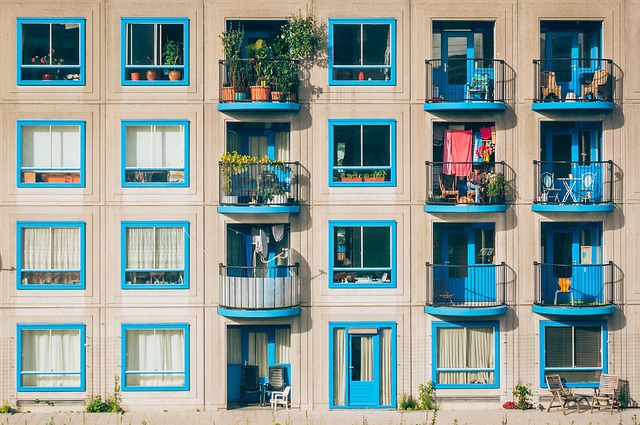Creating comfortable living spaces is crucial for college students' success and well-being in a bustling environment, offering a sanctuary from academic demands and social pressures. By designing dedicated zones for academics and socializing, incorporating calming decor, lighting, and natural elements, and leveraging technology, students can achieve a harmonious balance between their studies and social lives. These strategies enhance focus, reduce stress, and foster overall comfort, enabling students to thrive academically while enjoying a fulfilling college experience.
Creating comfortable college living environments is essential for students’ overall well-being and academic success. In this article, we explore strategies that combine personal sanctuary with a vibrant social life, focusing on dorm room design, lighting, natural elements, technology integration, and more. By understanding the importance of comfort in college, students can transform their spaces into havens that enhance productivity and foster community engagement, making their living experiences both enriching and relaxing.
- Understanding the Importance of Comfortable Living Spaces in College
- Balancing Social Life and Personal Sanctuary: Strategies for Students
- Designing Your Dorm Room for Optimal Comfort and Productivity
- The Role of Lighting and Color Schemes in Creating a Welcoming Environment
- Incorporating Houseplants and Natural Elements for Stress Relief
- Utilizing Technology to Enhance College Living Experiences
Understanding the Importance of Comfortable Living Spaces in College

Comfortable living spaces play a pivotal role in students’ overall college experience. Beyond simply providing shelter, these environments significantly impact academic performance and mental health. In the bustling college landscape, where social lives are vibrant and demands high, having a sanctuary that fosters relaxation and peace is essential. This is especially true considering the constant juggling of classes, studies, extracurriculars, and socializing—a delicate balance many students strive to maintain.
A comfortable living space serves as a counterpoint to the hectic college routine, allowing students to unwind, recharge, and prepare for the next day’s challenges. It contributes to better sleep quality, reduces stress levels, and enhances overall well-being—all of which are crucial for academic success. Moreover, such an environment promotes focus and productivity during study hours, enabling students to make the most of their time on campus.
Balancing Social Life and Personal Sanctuary: Strategies for Students

In the fast-paced college lifestyle, balancing social life and personal sanctuary is an art many students strive to master. With endless opportunities for socializing, from vibrant campus events to study groups and club activities, it’s easy to get swept away in a whirlwind of interactions. However, maintaining a sense of calm and comfort in one’s living space is vital for overall well-being and academic success. Students must create personal sanctuaries within their dorm rooms or off-campus residences that serve as retreats from the bustling campus life.
Strategies for achieving this balance include establishing clear boundaries, setting aside dedicated time for relaxation and self-care, and incorporating calming decor and organization techniques. Simple measures such as noise-canceling headphones, essential oils, cozy reading nooks, and minimalist designs can transform living spaces into peaceful havens. By creating a tranquil environment at home, students can recharge, find clarity, and approach social engagements with renewed energy and focus.
Designing Your Dorm Room for Optimal Comfort and Productivity

Designing your dorm room is an exciting way to transform a small space into a comfortable and productive sanctuary, especially as a college student juggling academics and social life. The key lies in creating zones for each aspect of your busy routine while maintaining a harmonious and visually appealing environment. Start by organizing your desk area, ensuring it’s well-lit and equipped with all the necessary study tools. A clutter-free space promotes focus and reduces stress during late-night cram sessions or exam preparation.
Consider incorporating cozy elements like a plush rug to add warmth and a comfortable chair to relax in between study breaks. Balancing social life with academic responsibilities is essential, so create a dedicated area for socializing too. This could be a small seating nook where you can chat with friends or even a mini-media center to host movie nights. With thoughtful design choices, your dorm room can become a relaxing retreat that supports both your educational pursuits and your need for social connections.
The Role of Lighting and Color Schemes in Creating a Welcoming Environment

Lighting and color schemes play a pivotal role in shaping the ambiance of a college living space, significantly influencing how comfortable and welcoming the environment feels for students. Soft, diffused lighting creates a cozy atmosphere, encouraging relaxation and study, while well-placed lamps can enhance reading nooks or common areas, fostering productive discussions and social bonding. Colorful accents, when incorporated thoughtfully, can transform spaces from bland to vibrant, boosting student morale and creating an engaging environment that balances social life with academic focus.
Consider using neutral color palettes as a base, which offer versatility for display through accessories and art, allowing students to personalize their space. Warmer hues like soft yellows or earthy tones promote relaxation and can make smaller rooms feel more expansive. Cooler colors like blues and greens, on the other hand, evoke calmness and are ideal for common areas where students gather to socialize, study, or unwind. Striking a balance between these color schemes helps create an inclusive environment that caters to diverse preferences while promoting overall comfort in college living quarters.
Incorporating Houseplants and Natural Elements for Stress Relief

Incorporating houseplants and natural elements into college dorm rooms or shared living spaces can significantly contribute to creating a comfortable and calming environment, especially when balancing a social life that often comes with academic demands. Plants act as natural air purifiers, improving indoor air quality by absorbing toxins and releasing oxygen—a refreshing change from the artificial environments many students spend their time in. Additionally, caring for houseplants can serve as a therapeutic hobby, offering moments of solitude and a sense of responsibility, helping to alleviate stress and anxiety.
Natural elements such as wooden furniture, woven textiles, or even small water features like tabletop fountains can enhance aesthetics while promoting a connection with nature. These additions create a peaceful atmosphere that invites students to unwind and relax, providing much-needed respite from the fast-paced college lifestyle. A well-planted and decorated living space encourages students to spend quality time in their accommodations, fostering a sense of belonging and comfort amidst the constant social and academic interactions.
Utilizing Technology to Enhance College Living Experiences

In today’s digital era, technology plays a pivotal role in enhancing college living experiences. Social media platforms and communication apps facilitate easy connections among students, fostering a sense of community within dorms and residential halls. Virtual study groups and online collaboration tools enable peers to balance their social life with academic responsibilities efficiently.
Moreover, smart home devices can contribute to creating a comfortable environment. From voice-controlled lighting and temperature adjustments to automated security systems, these innovations offer convenience and peace of mind. Students can focus on their studies or socialize without worrying about basic necessities, as technology steps in to simplify daily routines, ensuring a more enjoyable college living experience overall.






